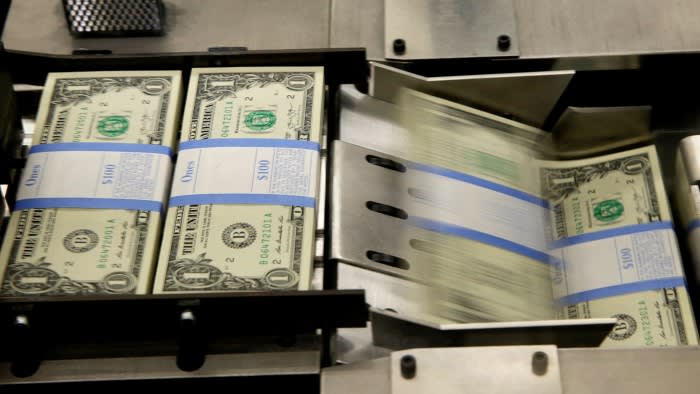Unlock the Editor’s Digest for free
Roula Khalaf, Editor of the FT, selects her favourite stories in this weekly newsletter.
The writer is a former chief investment strategist at Bridgewater Associates
After months of steady ascent, the dollar has been giving back gains in recent months. In the year to the end of July, the US currency climbed 5 per cent against a broad basket of peers tracked by the Federal Reserve. It then softened, largely thanks to increased expectations for lower interest rates that were confirmed with a half percentage point cut by the Fed in September. That made the dollar’s prospects relatively less attractive.
Today, though, such expectations are not likely to prove sufficient to keep the dollar on a downward trend, particularly after further evidence of strong job creation in the US last week.
After all, markets are supposed to price in publicly known information. That means the dollar’s current valuation already reflects expectations of another 1.5 percentage cut in the benchmark Fed fund interest rate between November and the end of 2025. Further rate cuts would require additional economic softening that while certainly possible, feels a bit further away after the latest, robust US jobs data. Ten-year Treasury bond yields have already been boosted by this, crossing the key 4 per cent mark.
And there are further broader forces that are likely to support the dollar. It is important to remember that exchange-rate trends are largely a function of cross-border trade and capital flows, as well as the factors that influence those flows, such as fiscal and monetary policy. Simply put, for the dollar to weaken, net capital inflows to the US (that is, dollar demand) need to be smaller than trade-related net dollar selling.
For most of the past decade, the dollar has benefited from a steady inflow of capital into US public and private equities and bonds, in addition to foreign funds coming to the US for direct investment. The attractiveness of dollar-denominated assets has been bolstered by strong growth, relatively attractive bond yields, and expectations that an innovative technology sector could help propel further stock market outperformance.
Today, one might argue that US assets have been loved too much, leaving both them and the dollar vulnerable. The 12-month forward price/earnings ratio for the S&P 500, as an example, has risen to 24 times. That is well over its 10-year average of 18, according to FactSet, and significantly above other major markets.
Attractive overseas market valuations are necessary but insufficient to prompt a sustained shift away from dollars. What history has repeatedly shown is that prolonged dollar weakness is more likely when the US economy and markets are doing fine, but macro conditions overseas are gaining momentum, in addition to having relatively more attractive valuations. That combination cannot only convince non-US investors to take capital back home but encourage American investors to increase their foreign asset allocations.
Such green shoots appeared in China over the last several days with a stimulus package and promise of more to come. Right on cue, investors bought Chinese equities and the renminbi, taking the currency to its highest level in about 16 months against the dollar. The question now is whether the government’s latest efforts will be enough to lift consumer confidence and spending meaningfully and sustainably.
For dollar bears, this matters. Without sustained improvement in growth outside the US in places like China and Europe, a US “soft landing” — even when supported by Fed easing — may end up just pulling more capital to dollar-based assets. It is the “best house on a bad block” syndrome.
Of course, there is also the potential for a resurgence of dollar strength into the new year, which could come through different channels. If Fed easing and underlying consumer resilience allow for US growth to outpace other economies, even more money may be channelled into dollar assets.
More problematically, the dollar could strengthen if the November US election results in a broader, more aggressive trade war that weighs down on expected growth overseas while reviving inflation at home, leading the Fed to slow down its easing cycle.
Finally, to the degree that history repeats itself, the dollar also could gain (or at least hold steady) if the world falls into a recessionary crisis. That environment tends to favour the liquidity and safety of US fixed income, with related capital flows helping the dollar in the process. The worst case for the dollar as we head into 2025 may be the best case for the global economy. For now, though, it is far from assured that dollar bears or global optimists will be rewarded.
https://www.ft.com/content/e24b219f-f26a-4341-b82d-f67485873712


